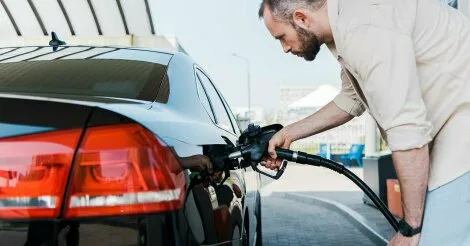Filling your car with the wrong fuel can be a disastrous mistake, potentially causing severe damage to your engine and leading to costly repairs. This common error happens more often than you might think, especially with the increased popularity of diesel and petrol vehicles. Recognizing the wrong fuel symptoms early can make all the difference in minimizing the damage and getting your vehicle back on the road safely. In this article, we will outline the critical steps you should take if you suspect you’ve made this mistake.
Immediate Signs of Wrong Fuel Symptoms
Understanding the initial wrong fuel symptoms is crucial in taking swift action. The symptoms may vary depending on whether you’ve put petrol in a diesel car or diesel in a petrol car, but some common indicators include:
- Engine Misfiring or Knocking: One of the first signs of wrong fuel is a noticeable engine misfire or knocking sound. This occurs because the engine isn’t receiving the proper fuel, leading to erratic combustion.
- Difficulty Starting the Engine: If you’re struggling to start the engine or if it stalls shortly after starting, this could be a clear indication of wrong fuel in the tank. The incorrect fuel won’t ignite properly, leading to starting issues.
- Excessive Smoke from the Exhaust: Diesel engines, in particular, may emit thick, black smoke from the exhaust when petrol is introduced into the system. This is due to the improper combustion of the wrong fuel.
- Warning Lights on the Dashboard: Modern vehicles are equipped with sensors that detect fuel-related issues. If you notice warning lights on your dashboard, especially those related to the fuel system, it’s a strong sign of contamination.
- Poor Vehicle Performance: A sudden drop in performance, such as reduced acceleration, sluggishness, or an overall lack of power, can be a clear indicator of wrong fuel.
Recognizing these symptoms early allows you to take immediate action, potentially saving your engine from severe damage. However, knowing the signs is only the first step. What you do next is equally important.
What to Do When You Detect Wrong Fuel Symptoms
Once you’ve identified the wrong fuel symptoms, it’s essential to act quickly and efficiently to prevent further damage. Here’s a step-by-step guide on what to do:
1. Turn Off the Engine Immediately
The moment you realize that you’ve put the wrong fuel in your car, switch off the engine. Continuing to run the engine will only circulate the contaminated fuel further into the system, increasing the risk of damage. By turning off the engine immediately, you minimize the chances of the wrong fuel reaching critical components like the fuel injectors, fuel pump, and engine cylinders.
2. Avoid Turning the Key Again
Even if your car hasn’t started yet, avoid turning the key again. Attempting to start the car will only pump more of the wrong fuel through the system. If you’re at a fuel station, it’s best to leave the car where it is and seek assistance.
3. Call a Professional Fuel Fixer
At this stage, it’s crucial to contact a professional fuel fixer. These specialists are trained to handle fuel mix-ups and can safely drain the wrong fuel from your tank, flush the system, and refill it with the correct fuel. Attempting to fix the problem yourself can be dangerous and may result in further damage to your vehicle. A professional fuel fixer has the necessary tools and expertise to resolve the issue quickly and efficiently.
4. Do Not Attempt to Drive
Driving your vehicle with the wrong fuel is one of the worst things you can do. Even if the car starts and seems to run fine, the damage may not be immediately apparent. Over time, the wrong fuel can corrode internal components, leading to more severe problems. It’s always best to wait for a fuel fixer to arrive and assess the situation.
5. Prepare for a Fuel Drainage Service
When the fuel fixer arrives, they will likely perform a complete fuel drainage service. This involves removing the contaminated fuel, flushing the fuel lines, and replacing the fuel filter if necessary. Once the system is clean, they will refill the tank with the correct fuel and test the vehicle to ensure everything is functioning correctly.
Why Choosing a Reputable Fuel Fixer Matters
Selecting the right fuel fixer is critical to ensuring your vehicle is returned to its optimal condition. A reputable fuel fixer will have experience dealing with all types of vehicles, from small cars to large trucks, and will use specialized equipment to perform the fuel drainage safely. Additionally, a trusted fuel fixer will provide you with peace of mind, knowing that your car is in capable hands.
What to Look for in a Fuel Fixer:
- Experience and Expertise: Ensure that the fuel fixer has a proven track record of successfully resolving fuel mix-ups.
- 24/7 Availability: Fuel mix-ups can happen at any time. Choose a fuel fixer who offers round-the-clock service.
- Transparent Pricing: A reputable fuel fixer will provide clear and upfront pricing with no hidden fees.
- Positive Customer Reviews: Look for a fuel fixer with strong customer testimonials and a reputation for excellent service.
By choosing a professional and experienced fuel fixer, you can be confident that your vehicle will be back on the road quickly and without further complications.
Preventing Wrong Fuel Mix-Ups in the Future
While knowing what to do in the event of a fuel mix-up is important, preventing the issue in the first place is even better. Here are some tips to avoid making the same mistake again:
- Double-Check the Fuel Nozzle: Always check the nozzle before filling up. Diesel nozzles are usually larger, so they shouldn’t fit into a petrol filler neck, but mistakes can still happen.
- Look at the Fuel Pump Label: Take a moment to read the label on the fuel pump. Make sure it matches your vehicle’s fuel type.
- Create a Habit: Develop a routine of checking the fuel type every time you fill up. Even if you’re in a hurry, it’s worth taking an extra second to confirm.
- Use Fuel Cap Labels: Consider adding a label inside your fuel cap as a reminder of the correct fuel type.
Conclusion
Filling up with the wrong fuel is a common but avoidable mistake. By recognizing the wrong fuel symptoms and taking immediate action, you can minimize the damage to your vehicle. Always turn off the engine, avoid driving, and contact a professional fuel fixer for assistance. Preventive measures, such as double-checking the fuel type before filling up, can help you avoid this costly error in the future.
for more read informative blog click here.



